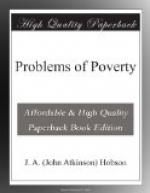Sec. 5. Steps in the Organization of labour.—The movements of labour show an order closely correspondent with those of capital. As the units of capital seek relief from the strain and waste of competition by uniting into masses, and as the fiercer competition of these masses force them into ever larger and closer aggregates, until they are enabled to obtain partial or total relief from the competitive strife, so is it with labour. The formation of individual units of labour-power into Trades Unions, the amalgamation of these Unions on a larger scale and in closer co-operation, are movements analogous to the concentration of small units of capital traced above. It is not necessary to follow in detail the concentrative process which is gradually welding labour into larger units of competition. The uneven pace at which this process works in different places and in various trades has prevented a clear recognition of the law of the movement. The following steps, not always taken however in precisely the same order, mark the progress—
1. Workers in the same trade in a town or locality form a “Union,” or limited co-operative society, the economic essence of which consists in the fact that in regard to the price and other conditions of their labour they act as a complex unit. Where such unions are strongly formed, the employer or body of employers deals not with individual workmen, but with the Union of workmen, in matters which the Union considers to be of common interest.
2. Next comes the establishment of provincial or national relations between these local Unions. The Northumberland and Durham miners will connect their various branches, and will, if necessary, enter into relations with the Unions of other mining districts. The local Unions of engineers, of carpenters, &c., are related closely by means of elected representatives in national Unions. In the strongest Unions the central control is absolute in reference to the more important objects of union, the pressure for higher wages, shorter hours, and other industrial advantages, or the resistance of attempts to impose reductions of wages, &c.




